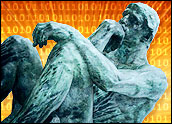
Sage took a major step in clarifying its position in the market when it hosted an analyst day in Boston last week. The company has been around for a long time and has been one of the higher revenue generators for many years thanks to an assortment of products that span the front and back offices of SMB companies. But the company grew through aggressive acquisition, and that left it with a hodgepodge of products and a weakly defined strategy.
A few years ago Sage had multiple overlapping accounting and CRM systems with weak integration, and the product line suffered in comparison to newer, cloud computing offerings from upstart competitors. The company still has challenges ahead of it, but in the last few years — a period that overlaps nicely with the leadership of North America CEO Sue Swensen — the company has begun to put its house in order.
Analysts had been treated to glimpses of a product strategy turnaround before, but last week’s meeting in Boston was by far the most cohesive delivery of Sage’s core strategy yet. The company must have thought so too, because in attendance were three high-ranking executives, including Guy Berruyer, Sage Group CEO; Swensen, CEO, North America; and her designated successor, Pascal Houillon, who will officially take over stewardship of the North American operation later this year when Swensen retires.
Sage still has a plethora of products and even now speaks of returning to an acquisitions strategy when the time is right. But the company is coming to terms with a need to refresh an aging product line and embracing cloud computing on terms that will cause minimal disturbance for its only channel to the marketplace — resellers.
Recognition for Resellers
The last point is not made lightly. Resellers are generally small companies that add value through consulting, customization and building long-term relationships that drip revenue into the bucket rather than pour it. Sage’s partners are not all technical vendors. Accountants, auditors, bookkeepers and others who advise small businesses recommend many Sage products around the world.
So there is little surprise that Sage’s strategy retains a three-tier character — cloud computing for the smallest, most cost conscious new arrivals; a hybrid approach for the broad middle; and updated traditional products for established businesses that want continuity and few surprises. This is progress, and it mirrors what many other vendors with large user populations — Microsoft and Oracle, for example — have done. There is no use in thinking about converting every conventional customer to the cloud in a short time, and these vendors have done their best to support and, where possible, future-proof their customers.
In line with all this, Sage added better definition to its customer-for-life strategy. Accounting and CRM are more sticky than either alone, according to the company’s experience, so logically, one part of its strategy is to grow accounts. But that requires multiple talents in its partner base or the alternative — cooperation between partners.
Beyond delivery modes, Sage has a three-part strategy to address the market. Two parts of the approach should not surprise anyone: Improve existing products in functionality and user experience and grow the Sage footprint within each account. Implicit in this approach is a prime directive to improve the customer experience wherever possible. So far, all of this would be standard for almost any business software vendor.
The third leg of the stool demands closer examination. Sage began selling what it calls “connected services” a while ago, and those services are the nucleus of a potential new vendor model that connects partners and customers as well as offering potential new profitability.
Connected services can be anything, and generally these services constitute either things that Sage can do in bulk that its end customers spend disproportionate amounts of time getting right, or highly specialized services that require outside expertise. Some of the offerings include employee benefit services, legal assistance and tax compliance, as well as more quotidian things like shopping cart, payment and backup services. These go beyond software and make the whole offering stickier. Other vendors should consider this approach.
Growing Ecosystem
The thing about connected services is that Sage need not be the only vendor in the mix, and an ecosystem is growing up around the model. This ecosystem provides a way for non-technical business services vendors to access a big market and for Sage, or any vendor, to add value. The model can and should provide a tollgate for vendors too, presumably because they provide the service of vetting the third party’s work quality.
This ecosystem most closely approximates the AppExchange form Salesforce, but unlike the AppExchange, the Sage ecosystem is open to non-technical service providers. A further advantage of this model for Sage is that it opens up a line of communication between it and the end customer that may not always be filtered through the partner. While this can be a delicate matter, as long as the services provided are not competitive, there should be no objection.
However, the open line of communication provides Sage with the ability to know and communicate with its customers better than in a model that requires all communication to be filtered through a partner.
Acquisitions of a Different Color
In the era ahead, increasing profitability in business software companies will depend on increasing the vendor’s footprint. But there is a practical limit on how much software a customer might buy or lease, and this is especially true in the SMB market, where the number of users per customer entity is low. Connected business services is more of a green field and offers greater growth prospects.
Finally, connected services is a smart way to educate customers — even reluctant ones — about the realities and benefits of cloud computing so that at some point in the future a move to the cloud might seem less daunting.
In many ways Sage has not changed much. It still has roughly the same constellation of products, but it has come to terms with the cloud and put together a future direction for its partners and customers that was hard to see before.
The company will return to its acquisitions model because that is in its DNA. But future acquisitions will probably have a cloud flavor, and they will likely further drive Sage in the general direction of the cloud. Very little, if any, of this approach was envisioned in “The Innovator’s Dilemma,” but if Clay Christenson writes a new edition, I could see this as a chapter.

























































